Thematic maps are a powerful yet often underutilized tool that can provide diverse businesses with meaningful location-based insights. By leveraging different types of thematic maps, organizations can better understand key metrics like sales performance, customer concentrations, and market opportunities across their territories.
This article will explore the definition of thematic maps, several commonly used types, and how businesses can create effective maps to enhance strategic decision-making. Whether you're a staffing firm looking to optimize field teams or a manufacturer aiming to expand into new regions, thematic maps offer a straightforward way to visualize spatial patterns in your most important business data.
What are thematic maps?
A thematic map, or statistical map, is a type of map visualization designed to illustrate a particular dataset or attribute. As per the formal thematic map definition geography provides, thematic maps solely depict the distributions, densities, and patterns of a chosen theme or variable across a geographic area.
So why use a thematic map? When it comes to thematic maps vs. reference maps, reference maps show physical landscape features or political boundaries, whereas thematic maps filter out those locating details. Instead, they use color, shading, symbols, and proportional symbols like scaled circles to highlight the spatial footprint of user-selected information.
Common thematic mapping attributes include:
- Demographics like age, income level, and education
- Economics metrics like employment rates
- Business data such as sales performance, market share, or number of retail outlets
- Scientific information like climate factors, vegetation zones, and soil types
- Voting patterns and election result maps
- Disease rates and outbreak hotspots in public health
In short, a thematic map filters out unnecessary details about physical locations and terrain and spotlights solely on depicting distributions and densities of user-selected information. So, you see patterns in data instantly.
Businesses can leverage thematic maps in territory mapping software solutions to identify new expansion opportunities, optimize territories for sales and operations teams, locate ideal sites for new retail outlets, model service coverage gaps, improve marketing efficiency, pinpoint areas of high insurance risk, and more.
Types of Thematic Maps
Certain thematic map types may prove more suitable than others depending on your specific business goals and available data sources. Some frequently used options include:
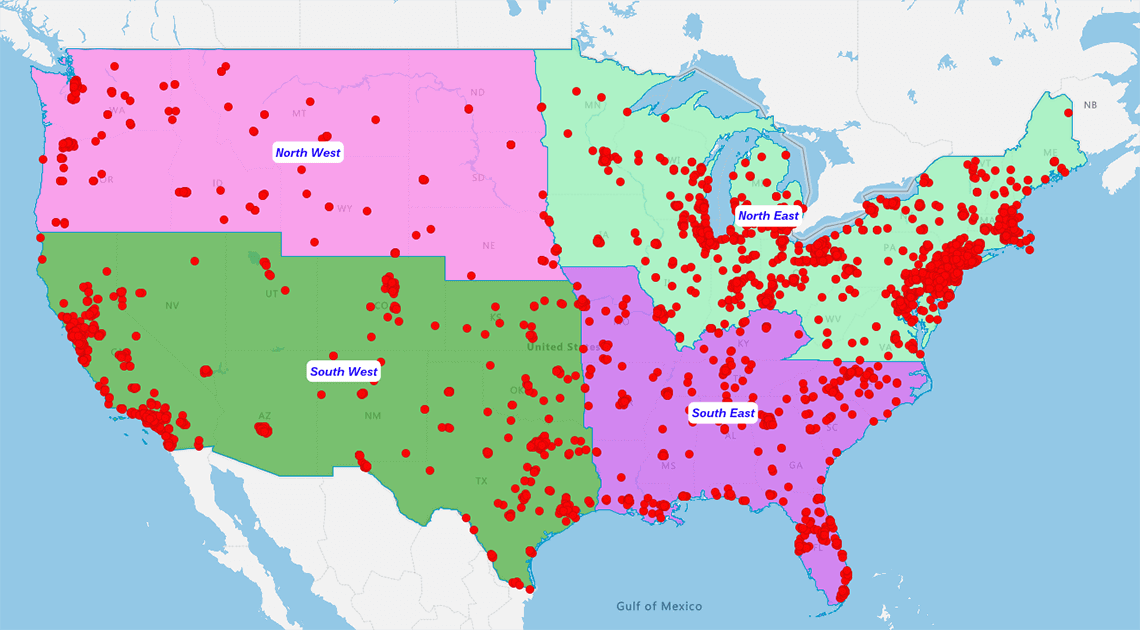
1. Choropleth Maps
Choropleth maps use color density or shading to depict differences in statistical values over a geographic area. Darker shades represent higher measured values, while lighter shades indicate lower values.
Some common attributes displayed in choropleth maps include:
- Population density
- Sales performance by territory/region
- Household income levels
- Election results/voting patterns
- Market penetration
- Crime rates
- Insurance claims rates
- Disease rates
Choropleth maps excel at providing regional overviews for businesses. Operations sales and marketing teams can quickly visualize performance across territories at a high level and identify areas of opportunity or concern for further investigation.
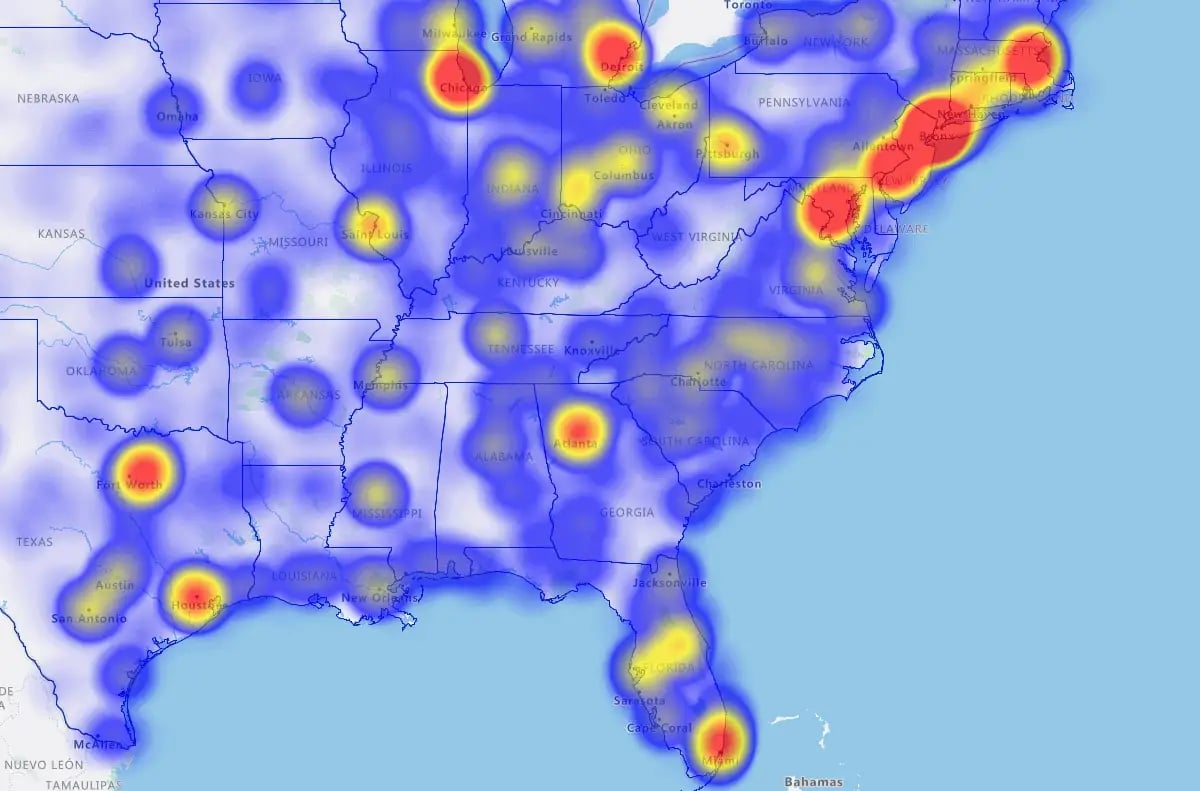
2. Heat Maps
Heat maps also use color to represent data variable intensity but with more of a continuous color gradient. Like weather maps, which show temperature variations across a region, heat maps leverage a color scale to visually depict the density or concentration of a particular metric within a given area.
A subtype of heat maps is regional heatmaps. These summarize statistics like sales, customers, or market potential and color code regions based on the mapped variable's value.
Some typical applications of heat mapping are:
- Visualizing customer concentrations and hotspots of sales activity
- Displaying website click frequency and visitor engagement by locale
- Comparing market potential across regions to identify areas of growth
- Illuminating crime-rate patterns to support data-driven policing strategies
- Pinpointing disease outbreak hotspots and high-risk areas
According to the political map definition geography provides, standard political maps illustrate boundaries and state divisions rather than spotlighting intensity patterns of statistics. Heat maps take the specialized thematic approach instead.
With heat mapping software, businesses can zero in on the “hot spots” for a chosen metric, like revealing their most profitable sales regions and ideal sites for opening new locations. A good platform offers flexible geographic heat mapping to visualize custom location-based data.
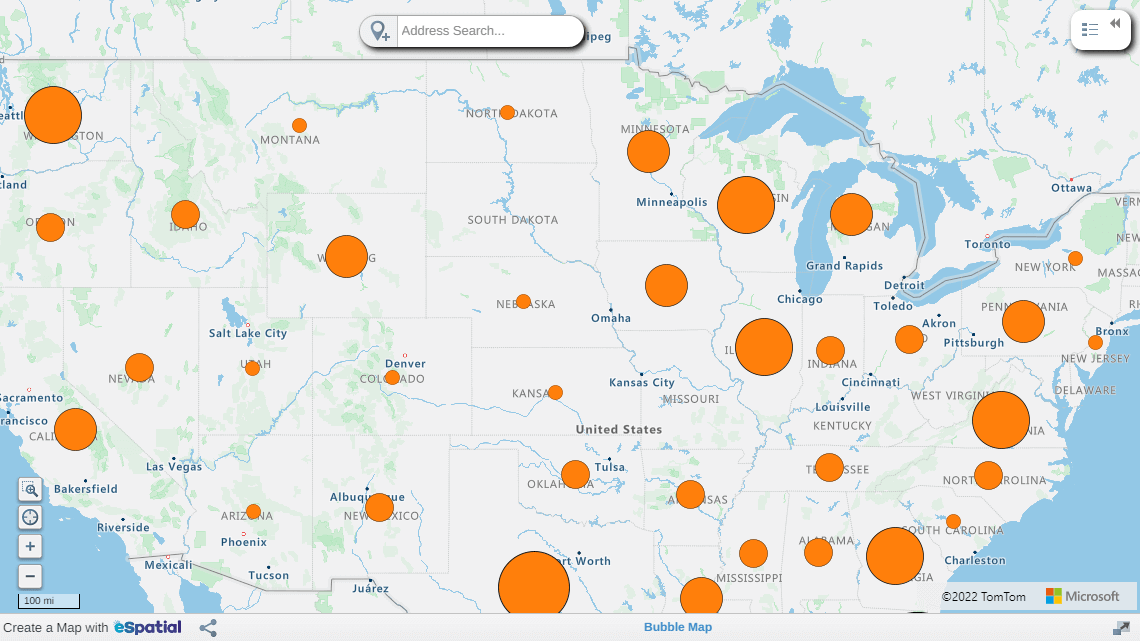
3. Bubble Maps
Unlike choropleth and heat maps, bubble maps use proportional symbols rather than color to depict variances in the mapped variable. Typically, the bubbles are scaled directly to the data attribute value, so a region with double the value would display a bubble twice the size.
Business applications of bubble maps include:
- Showing variation in market size, total customers, or buying power across regions
- Identifying highly saturated areas vs regions with room to grow
- Displaying demographic statistics like average household size
- Modeling retail site suitability based on surrounding population reach
- Mapping gaps in service coverage relative to user demand
As the physical map definition outlines, physical maps illustrate geographic elements like roads, cities, and landscape features. Thematic maps, like bubbles, filter these out and spotlight statistical attributes instead.
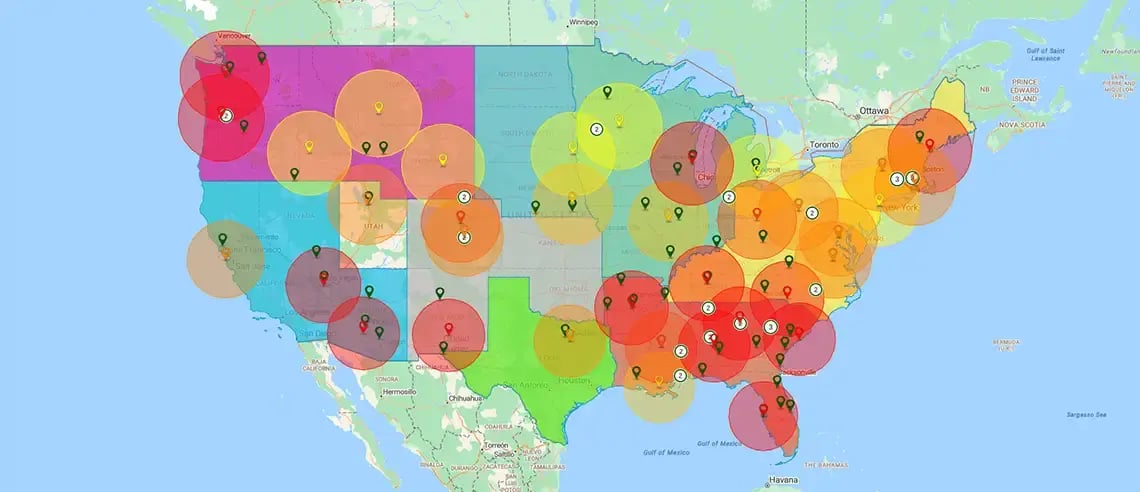
4. Radius Maps
Radius maps illustrate information about geographic points within a defined radius area. The radius boundary is typically centered around focus locations (such as existing stores).
Common radius map applications include:
- Showing customer locations within a few miles of each store
- Modeling service coverage capacity for a given radius
- Identifying gaps in coverage that new sites could fill
Regions can be color-coded by the total metric value of enclosed points. For example, a coffee shop could map household spending power within 5 miles of proposed sites. Darker shader areas have greater buying power reach, guiding efficient location planning. Ultimately, radius maps can help businesses spot nearby opportunities and optimize locations based on surrounding demographics and activity.
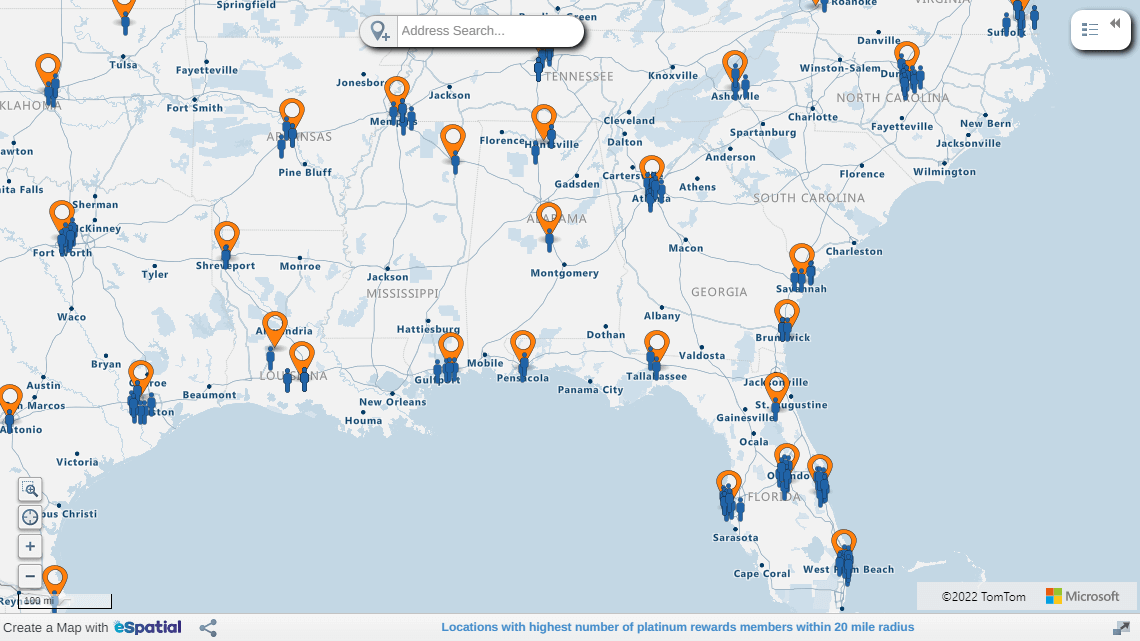
5. Nearest Neighbor Maps
Nearest neighbor maps identify and display the closest point locations that match desired attributes or criteria. Typically, the mapped points feature distance lines connecting back to central positions.
Common examples include:
- Identifying the top 10 customer sites ordered by drive time proximity for optimal dispatch routing
- Finding the closest repeat-sales prospects to upsell based on past purchase locations
- Identifying gaps in sales coverage relative to customer proximity
- Spotting emerging local competitors to inform marketing responses
Unlike general maps showing all roads and cities, nearest-neighbor analysis filters views to only the most important points based on proximity. For businesses, these maps can provide localized insights to help leaders make informed, location-based decisions.

6. Drive Time Maps
As the name suggests, drive time maps delineate the area reachable within a specified drive time from target locations (such as warehouses). They illustrate areas reachable within set durations from each focus point.
Common example applications include:
- Mapping customers, competitors, or partners reachable within 15 minutes of each store for sales and marketing strategies
- Modeling 20-minute food delivery zones from a restaurant to balance order volume and logistics
- Identifying healthcare access gaps based on 30-minute drive times to facilities as a public health initiative
Mapping drive times factors in travel speeds, road infrastructure, and regional geography, providing businesses with more realistic data that help them make informed decisions.
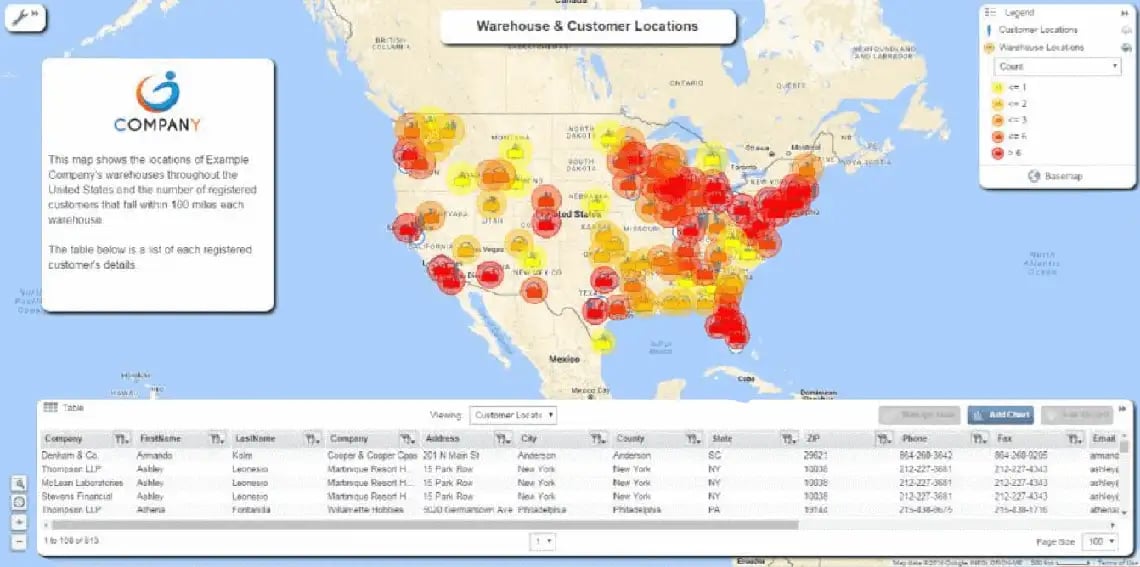
7. Aggregate-by Value Maps
Aggregate-by-value maps categorize records based on a variable and then display summarized statistics by region. These maps help segment populations into groups for comparison.
Typical business uses include:
- Sales segmented by deal status for performance analysis
- Service cases categorized by issue type and priority level
- Grouping customers into value tiers
- Product sales aggregated by item family
For example, a retail chain could use an aggregate-by-value map to break out sales by product category over the past quarter. The map would shade regions based on the total sales value from categories like apparel, electronics, home goods, and grocery. This allows businesses to visually identify differences in buying patterns across regions. The intelligence fuels targeted marketing and tailored inventory by location.
Whatever thematic map type(s) you choose, carefully considering your business goals and metrics will lead you toward the most effective revealing. With practice applying the techniques explored below, you can generate actionable location-based insights from thematic maps.
Creating effective thematic maps for business purposes
With so many possible applications, thematic maps deliver immense value to business intelligence workflows. But simply having access to mapping capabilities doesn't guarantee effective results. Creating handy thematic maps requires carefully designing around the specific business need by using the right inputs, methodology, and tool configuration.
When creating a thematic map, it's critical to follow best practices:
1. Choose the right map type
Select the map type that will best highlight the precise data patterns and distributions you need to analyze for your business purpose. Match choropleth maps to regional overviews, heat maps to intensity, bubbles for totals, etc.
2. Input data
Flawed data destroys the reliability of any map's insights. Before mapping, validate information accuracy, fill gaps, structure data, geocode records, and normalize metrics.
3. Incorporate analytical features
Configure tools to automatically surface patterns plus allow custom analytics like thresholds, segmentation, change comparisons over time, blended data views, demographic expansion, and more.
By following best practices and continuously improving maps over time, your thematic creations will yield progressively richer and more actionable business value. Combined with mapping technologies, users can rapidly generate location intelligence at their fingertips.
Mapping solutions for businesses from eSpatial
As a leader in location intelligence software, eSpatial's powerful mapping software offers a full suite of thematic mapping capabilities to empower strategic business growth. With the flexibility to instantly map company data like operations, manufacturing or delivery sites, sales, customer sites, and service events, the eSpatial platform reveals hidden geographic insights without requiring extensive GIS knowledge.
So, why wait? Gain a location-based competitive edge from thematic views of your most vital metrics. Start creating your territory maps immediately with our territory mapping software and territory management solutions. Contact us today for a customized demo!
 by
by 
